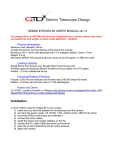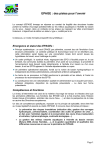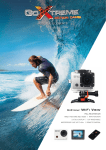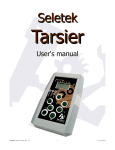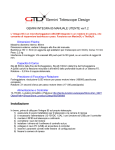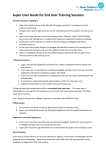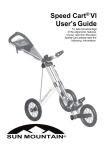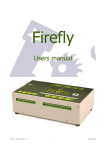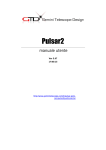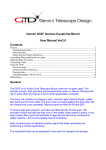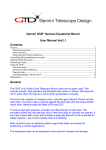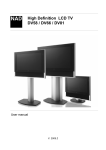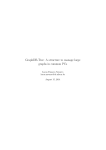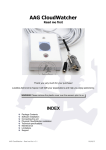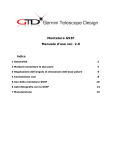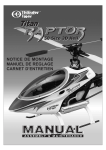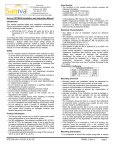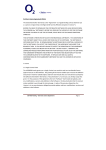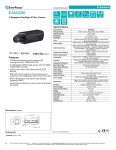Download User`s manual Integra RF 80
Transcript
GEMINI INTEGRA RF 80 USER'S MANUAL ver1.2 The RF 80 is an ASCOM microfocusser integrated into a camera rotator that saves you backfocus and weight. It works under MaximDL. Phisical dimensions Barrel inner diameter: 80mm (the barrel is exchangable, smaller diameters available on request) Ouside diameter: 155mm Minimum backfocus: 62mm (with 2” adapter rim added), Travel: 9 mm Weight: 1700 g Mounting interface: M6 push-pull screws at 3x120 degree, on R65mm circle Loading capacity 8kg @ 50mm from focusser end, 5kg @ 100mm from focusser end At these loads the measured flexture is within the focus depth of an F5 system. Rotator – 1,5 Nm unbalanced torque. Focusing/Rotating Precision Focusser: 2.4 micron resolution at full motor step (1.2 in half step mode) Rotator: 9/18 arcsec per full motor step (400/200 step motor) Power and Driver 12-15VDC, Lunatico Armadillo or Platypus http://tienda.lunatico.es/epages/Store.sf/en_GB/? ObjectPath=/Shops/Store.Lunatico/Categories/Seletek Installation In short, before using the RF80 on your scope 1) make sure you have the adapter for the telescope and the camera 2) you have the power supply (12-15VDC 1.5A), cables (motor, USB) for the driver 3) mount the RF80 on the scope and collimate it 4) connect the motor cables 5) install the drivers and control software on the PC 6) connect the PC cable (USB) and power up the driver 7) enter the correct parameters into the setup windows 8) attach the camera Mounting the RF 80 on the scope Rotating the coupling with your index finger bring the rotator in a position (one of 3) where the mark on the side lines up with the larger opening on the top cover: Now you can insert the 3 pc M6 mounting screws with a 4mm allen key into the larger openings and all the way down till you can see them come out at the bottom. Keep the RF 80 in vertical position (screws will stay in) and attach it to the telescope interface that you have previously mounted on the scope. Drive the mounting screws in with the 4mm key (do not tighten firmly yet) and then collimate the RF80 using both the 4mm and 3mm keys, like you would a lens cell or a secondary mirror. You can use a laser and a center mark on the secondary or any other optical element that is facing the focusser. Connecting Cables Connect the supplied motor cables to the Main (focusser) and Aux (rotator) ports of the driver as shown at right... ... then to the RF 80 rotator …. ...and focusser. Installing Drivers and Software You need to have the latest ASCOM platform installed before proceeding. Install the Seletec drivers and software from the CD or the latest from: http://www.lunatico.es/site/ourproducts/seletek-armadillo-platypus/technicalinformation/firmware-and-software.html Configuring the Software Now you can connect the driver to the PC and power up the driver (12-15VDC, 1.5A, 5.5/2mm DC power plug, center positive). From the program group select SELETEC, then again SELETEC and click “Configuration”. Please configure according to this screen. The next step is setting up the configuration of the focusser and the rotator. Start with the focusser (Main port) by clicking “Go” in the above window. 1) enter the parameters as seen below, 2) exit setup and check if moving OUT really moves the focusser out, 3) if not, reopen the configuration window and click “Reverse button's motion”, 4) take the focusser to the outermost position, where it stalls, return a few steps, reopen the configuration window and click “Set outermost”, exit setup, 5) take the focusser to the innermost position, where it stalls, return a few steps, reopen the configuration window and click “Set innermost”, exit setup. Note: you will need to experiment to get the correct value of backlash. It is normally between 5 -30 steps. Proceed with the Rotator (Exp port) and enter the parameters. At “A” you have to enter the step count of the motor (written on the back of it, 200 or 400). At “B” set the voltage in percentage of the supply to protect the driver from overheating. With 12V enter 70%, with 15V 55%. Note: the driver is rated for 1A current. The motor has 6 Ohm windings. With 12V the current is 12/6=2A, so you have to reduce voltage to avoid overheating during prolonged rotator operation. On the other hand reducing the current reduces motor torque. The 70% setting is a compromise that works. The maximum rotation at a time normally does not exceed 180 deg which also limits the maximum operation time to about 40 sec. Attaching the Camera You will need an adapter for your camera. The adapter is secured by 3pc M4x5mm setscrews. The setscrew positions are accessible with the focusser barrel fully OUT. You will need a 2mm Allen key to insert the setscrews, as shown at right. If you are using your own adapter make sure it has a tapered setscrew recess, otherwise your camera will not be held in position correctly. Check the illustration below! Using the RF 80 with MaximDL In Maxim click View/Observatory Control/Setup and at the Focusser click Options/Choose. In the ASCOM chooser select Seletec Focusser (Main port). You must do the setup of the rotator similarly, clicking the Options at the Rotator setup. You can see an autofocus session result at right. It is important to configure Maxim autofocus options correctly (system F No.,central obstruction, focusser step size) to get a good result. Care of your RF 80 Protect the anodised aluminium surfaces with silicone or paraffin oil twice a year. Do not use solvents to clean the surfaces. Do not oil the focusser drive pinion. If the adapter gets stuck in the barrel do not force it. Remove the cover plate as shown below and unscrew the barrel. Now you can use force to separate the parts. www.geminitelescope.com Innovation and Service since 1996








